Polyolefin substitute
PBS as a biodegradable polyolefin substitute
The polyolefins PE1 and PP1 are multifunctional plastics that shape our lives in many areas – at the same time, however, they cause a lot of waste in the environment. Nevertheless, it is neither possible nor reasonable to avoid using polyolefins. Rethinking plastics is therefore the premise of CCPE research. The consistent further development of bioplastics such as PBS2 is an important focus here.
One approach to reduce the waste problem is the increased implementation of mechanical and chemical recycling technologies, including the necessary collection systems for polyolefins. However, the recycling of plastic products containing polyolefins is always a challenge and cannot be achieved in the required quality (downcycling) or quantity (purification losses) without the supply of virgin material. Alternatives such as bio-based plastics will therefore gain in importance in the future if climate neutrality or net CO2 emissions close to zero are to be achieved.
A promising base material already available on the market is polybutylene succinate (PBS), which is produced from biobased raw materials and is biodegradable. However, in order to cover such a broad property profile as possible with the large variety of PE grades (HDPE, LDPE and LLDPE3), specific PBS grades must also be developed.
At the Fraunhofer IAP, researchers are developing suitable synthesis processes that can also be implemented industrially. In doing so, they pursue different approaches to vary the processing and product properties. In collaboration with the Fraunhofer IAP Biopolymer Processing Technical Center in Schwarzheide, they are producing blown films, among other things, in order to investigate the influence of structural variations on the processing and property of PBS blown films, as well as to identify new areas of application. Initial results show that the controlled introduction of branches4 leads to improved processing behavior for blown film production. The promising initial results will help to demonstrate the potential of PBS to manufacturers of polymers and plastic products and establish new applications for this diverse material.
Contact persons:
Research Department Circular Polymers and Circular Additives and Compounds
c/o Fraunhofer IAP | Geiselbergstraße 69 | 14476 Potsdam
Daniel Zehm (daniel.zehm@iap.fraunhofer.de, Tel. +49 331 568-1318)
Thomas Büsse (thomas.buesse@iap.fraunhofer.de, Tel. +49 331 568-3403)
________________________________________________________________________________
1) Polyolefins are thermoplastically processable mass plastics that account for about half of the world's plastics production. The group of polyolefins includes polyethylene (PE) and polypropylene (PP).
2) PBS is the abbreviation for polybutylene succinate and is assigned to the plastic class of polyesters. PBS is biobased, is biodegradable and is processed thermoplastically. For example, in film production and thermoforming.
3) HDPE is the abbreviation for high-density polyethylene, LDPE stands for low-density polyethylene, and LLDPE for linear low-density polyethylene.
4) Branches are very long side chains on the main chain of the polymer.
More Information
- Pilot plant for biopolymers Schwarzheide (iap.fraunhofer.de)
- Polymer Synthesis (iap.fraunhofer.de)
